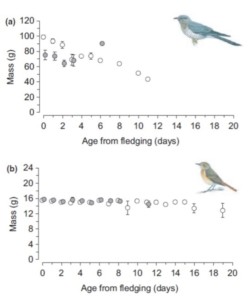LINKED PAPER
Post‐fledging interactions between the Common Cuckoo Cuculus canorus and its cavity‐nesting Common Redstart Phoenicurus phoenicurus host. Kysučan, M., Samaš, P. & Grim, T. 2019. IBIS. DOI: 10.1111/ibi.12719. VIEW
The Common Cuckoo (Cuculus canorus) is infamous for parasitizing the nests of other species. At the right moment, the female Cuckoo flies to the host’s nest, pushes one egg out, lays her egg and flies off. After about 12 days, the Cuckoo chick hatches and methodically removes any unhatched eggs along with its stepbrothers and –sisters from the nest. Next, it monopolizes the constant supply of food from the hosts, growing rapidly. At 14 days old, the chick is about three times the size of the small songbirds its parasitizes.
Fledglings
The Common Redstart (Phoenicurus phoenicurus) is the only known European cavity-nesting songbird that is targeted by the Common Cuckoo. A nest placed in a cavity hinders the eviction of host eggs or hatchlings by the Cuckoo chick, often resulting in mixed broods (Samaš et al. 2016). This situation provides the ideal circumstances to study the interactions between the Cuckoo chick and Redstart nestlings. A team of Czech ornithologists focused on the post-fledgling period, the time after young birds leave the nest but before they become independent (Cox et al. 2014). The researchers followed the ups and downs of Common Cuckoos and Common Redstarts in southeastern Finland. How well do birds from mixed broods perform compared to those from single-species broods?

Figure 1 The post-fledgling mass of (a) Common Cuckoos and (b) Common Redstarts that grew up in mixed broods (grey circles) or single-species broods (white circles). Common Cuckoo chicks from mixed broods had lower body mass when they left the nest, but they caught up with the birds from single-species broods. There were no differences in body mass between Common Redstart fledglings from mixed or single-species broods.
Undivided attention
Let’s start with the Common Cuckoo. Birds that grew up alone in a Redstart nest had higher mass and started to fly at a younger age than cuckoos from mixed nests. However, over the course of the post-fledgling period the birds from the mixed broods caught up. This observation can be explained by the feeding behaviour of the Common Redstart. In mixed broods, one of the adult Redstarts follows the Redstart fledglings which leave the nest almost one week before the Cuckoo chick does. The other adult gives its undivided attention to the Cuckoo chick, which may improve its condition after leaving the nest.
Personal heating
What about the Redstart nestlings? Surprisingly, they did not suffer from sharing the nest with a Cuckoo chick. The presence of a Cuckoo might even be beneficial for the Redstarts. The large size of the Cuckoo chick affects the thermoregulation in the nest. In some sense, the Cuckoo chick is ‘brooding’ its fellow Redstart nestlings (Grim et al. 2014). Moreover, food provision might be better for Redstart chicks in a mixed brood. Cuckoo nestlings almost exclusively eat insects, while Redstarts also feed on other food sources, such as fruit and small lizards. It could thus be better to share the nest with a picky Cuckoo chick than with another Redstart nestling (Samaš et al. 2018). Taken together, these results indicate that the interactions between Common Cuckoo and Common Redstart are evolutionary stable for both hosts and parasites.
References
Cox, W. A., Thompson, F. R., Cox, A. S. & Faaborg, J. 2014. Post‐fledging survival in passerine birds and the value of post‐fledging studies to conservation. The Journal of Wildlife Management 78: 183-193. VIEW
Grim, T., Samaš, P., Procházka, P. & Rutila, J. 2014. Are tits really unsuitable hosts for the Common Cuckoo? Ornis Fennica 91: 166-177. VIEW
Samaš, P., Rutila, J. & Grim, T. 2016. The common redstart as a suitable model to study cuckoo-host coevolution in a unique ecological context. BMC Evolutionary Biology 16: 255. VIEW
Samaš, P., Rutila, J., Honza, M., Kysučan, M. & Grim, T. 2018. Rearing a virulent common cuckoo is not extra costly for its only cavity-nesting host. Proceedings of the Royal Society B 285: 20181710. VIEW
Image credits
Featured image: Common Cuckoo Cuculus canorus | Chris Romeiks | CC BY-SA 2.5 Vogelart.info





